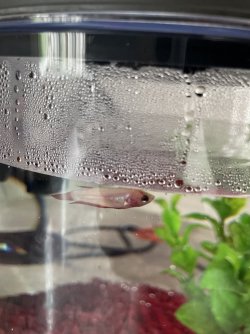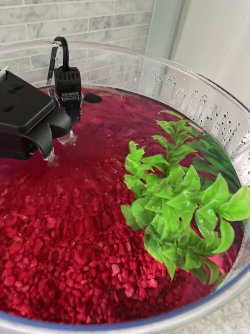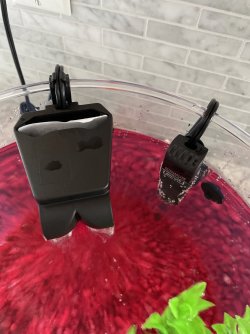Hi there! I recently got a baby male Betta from Petco. He was swimming around happily in the little container he came in. Yesterday I filled his tank (2.2 gallons), added the water conditioner, turned on the filter it came with, and turned on the heater. After 12 hours, my husband slowly submerged him into the water using the container. (Maybe not slow enough?) Foe the last 12 hours he is just hanging out on top of the tank. First I found him behind the filter, so I moved the filter. After that I’ve just been finding him on top of the tank like this. Is the water too warm? Or is there not enough oxygen? Attaching photos of fish, tank, filter. And yes, he is eating if given food. HELP!
You are using an out of date browser. It may not display this or other websites correctly.
You should upgrade or use an alternative browser.
You should upgrade or use an alternative browser.
Baby Betta Help
- Thread starter Sof25
- Start date
-
- Tags
- betta betta (male) betta baby
The April FOTM Contest Poll is open!

🏆 Click to vote! 🏆
Welcome to the forum.
What is the temp of the tank?....TBH, 2.2G is not large enough for a single betta...and, the tank is not cycled...see here: https://www.fishforums.net/threads/cycle-your-tank-a-complete-guide-for-beginners.475055/
What is the temp of the tank?....TBH, 2.2G is not large enough for a single betta...and, the tank is not cycled...see here: https://www.fishforums.net/threads/cycle-your-tank-a-complete-guide-for-beginners.475055/
Myraan
Fishaholic
My guess is the main issue causing the hiding is partly lack of other places to hide and partly too much flow from the filter.
But soon you will have much bigger issues than that if you do not follow the advice in post #2
But soon you will have much bigger issues than that if you do not follow the advice in post #2
I don’t mean to sound ignorant - I read the post you just sent - I did cycle before I put him in. Waited 12 hours until I added him into the water. My next question is - how do I cycle it now? Meaning where does he go and what do I need to do?Welcome to the forum.
What is the temp of the tank?....TBH, 2.2G is not large enough for a single betta...and, the tank is not cycled...see here: https://www.fishforums.net/threads/cycle-your-tank-a-complete-guide-for-beginners.475055/
Temp is 86. I will go get a bigger tank today. Thanks for your help. I am so worried about him!I don’t mean to sound ignorant - I read the post you just sent - I did cycle before I put him in. Waited 12 hours until I added him into the water. My next question is - how do I cycle it now? Meaning where does he go and what do I need to do?
Maybe I didn’t “cycle” correctly? I’m sorry I’m so new to this!Temp is 86. I will go get a bigger tank today. Thanks for your help. I am so worried about him!
No need to apologize, we were all beginners, at some point.
Read the cycling sticky I provided above...a "fishless" cycle is easier to do, and less stressful on the fish (and the fishkeeper), but unless you can return the betta, cycle the new larger tank, THEN get a new betta, you will be doing a "fish-in" cycle, or cycling with fish....regardless, it will be much better with a proper size tank (at least 5.5G)
A cycle does not happen in 12 hours.
Read the cycling sticky I provided above...a "fishless" cycle is easier to do, and less stressful on the fish (and the fishkeeper), but unless you can return the betta, cycle the new larger tank, THEN get a new betta, you will be doing a "fish-in" cycle, or cycling with fish....regardless, it will be much better with a proper size tank (at least 5.5G)
A cycle does not happen in 12 hours.
Myraan
Fishaholic
Did you read the link to a sticky post too? Cycling will not take 12 hours unless you have a lot of plants that haven't died in the 12 hours and a small amount of fish.
The fish will be producing ammonia, so you are the position of doing a fish-in cycle. If the petstore sold you a bottle of bacteria to add to cycle the tank, that will probably be a help.
You should read the sticky on fish-in cycling linked in the link.
Basically you should be testing everyday and doing a 50% plus water change each time the result for ammonia or nitrite is more than zero. A larger tank makes this easier because more ammonia is required to make a certain reading because of dilution.
IMO the biggest issue with the small tank is the lack of plants and decorations to make the fish feel more secure and less stressed.
Real plants will eat up ammonia as it is produced, and if you a lucky the tank will below pH7 which means the ammonia is less toxic
@Slaphppy7 beat me to post same thing.... less random waffle so faster typing
The fish will be producing ammonia, so you are the position of doing a fish-in cycle. If the petstore sold you a bottle of bacteria to add to cycle the tank, that will probably be a help.
You should read the sticky on fish-in cycling linked in the link.
Basically you should be testing everyday and doing a 50% plus water change each time the result for ammonia or nitrite is more than zero. A larger tank makes this easier because more ammonia is required to make a certain reading because of dilution.
IMO the biggest issue with the small tank is the lack of plants and decorations to make the fish feel more secure and less stressed.
Real plants will eat up ammonia as it is produced, and if you a lucky the tank will below pH7 which means the ammonia is less toxic
@Slaphppy7 beat me to post same thing.... less random waffle so faster typing
You will need a good quality testing kit, get one of these ASAP: https://apifishcare.com/product/freshwater-master-test-kit
You will also need a good quality water conditioner...get either Seachem Prime, or API Tap Water Conditioner
You will also need a good quality water conditioner...get either Seachem Prime, or API Tap Water Conditioner
Too high, lower it to around 80F, if you are able...Temp is 86. I will go get a bigger tank today. Thanks for your help. I am so worried about him!
Cycling is growing good bacteria to remove poisonous fish waste which takes a few weeks. The best way is growing them before fish are put in the tank by adding ammonia from a bottle to simulate fish waste. But as you have fish, you can't do this, so you are now doing a fish-in cycle.
Fish excrete ammonia (it's their version of urine) and in a brand new tank like yours there are none of the good bacteria to 'eat' this ammonia so it builds up in the water where it burns their skin and gills - and it's hard for them to take up oxygen from the water with burned gills so they go to where there is most oxygen, just under the water surface.
Eventually the ammonia eaters start to grow and they turn ammonia into nitrite. This is also poisonous - it binds to the fish's blood so it can't take up oxygen (similar to what carbon monoxide does to us). In a few more weeks, enough nitrite eaters will grow to remove all this nitrite.
Because these two things are poisonous we need to remove them from the water by taking a lot of the water out of the tank and replacing it with nice new clean water.
To do this properly you need testers for ammonia and nitrite and test the water every day. Whenever the reading is more than zero, do a water change. It is important to add water conditioner to the new water and warm it to roughly the same temperature as the tank.
The previous posters have mentioned live plants. Plants use ammonia as fertiliser and they turn it into protein not nitrite. If there are a lot of plants, they can take up all the nitrite made by the fish in the tank.
Fish like floating plants and these are particularly good at taking up ammonia. Even several stems of anacharis left to float will help. It might not look pretty but the betta will like it.
Fish excrete ammonia (it's their version of urine) and in a brand new tank like yours there are none of the good bacteria to 'eat' this ammonia so it builds up in the water where it burns their skin and gills - and it's hard for them to take up oxygen from the water with burned gills so they go to where there is most oxygen, just under the water surface.
Eventually the ammonia eaters start to grow and they turn ammonia into nitrite. This is also poisonous - it binds to the fish's blood so it can't take up oxygen (similar to what carbon monoxide does to us). In a few more weeks, enough nitrite eaters will grow to remove all this nitrite.
Because these two things are poisonous we need to remove them from the water by taking a lot of the water out of the tank and replacing it with nice new clean water.
To do this properly you need testers for ammonia and nitrite and test the water every day. Whenever the reading is more than zero, do a water change. It is important to add water conditioner to the new water and warm it to roughly the same temperature as the tank.
The previous posters have mentioned live plants. Plants use ammonia as fertiliser and they turn it into protein not nitrite. If there are a lot of plants, they can take up all the nitrite made by the fish in the tank.
Fish like floating plants and these are particularly good at taking up ammonia. Even several stems of anacharis left to float will help. It might not look pretty but the betta will like it.
How do I add water that is the same temperature? Meaning what is the safest way to add warm water without contaminating?Cycling is growing good bacteria to remove poisonous fish waste which takes a few weeks. The best way is growing them before fish are put in the tank by adding ammonia from a bottle to simulate fish waste. But as you have fish, you can't do this, so you are now doing a fish-in cycle.
Fish excrete ammonia (it's their version of urine) and in a brand new tank like yours there are none of the good bacteria to 'eat' this ammonia so it builds up in the water where it burns their skin and gills - and it's hard for them to take up oxygen from the water with burned gills so they go to where there is most oxygen, just under the water surface.
Eventually the ammonia eaters start to grow and they turn ammonia into nitrite. This is also poisonous - it binds to the fish's blood so it can't take up oxygen (similar to what carbon monoxide does to us). In a few more weeks, enough nitrite eaters will grow to remove all this nitrite.
Because these two things are poisonous we need to remove them from the water by taking a lot of the water out of the tank and replacing it with nice new clean water.
To do this properly you need testers for ammonia and nitrite and test the water every day. Whenever the reading is more than zero, do a water change. It is important to add water conditioner to the new water and warm it to roughly the same temperature as the tank.
The previous posters have mentioned live plants. Plants use ammonia as fertiliser and they turn it into protein not nitrite. If there are a lot of plants, they can take up all the nitrite made by the fish in the tank.
Fish like floating plants and these are particularly good at taking up ammonia. Even several stems of anacharis left to float will help. It might not look pretty but the betta will like it.
As you are in the USA you can use a mix of hot and cold tap water. It doesn't need to be exactly the same temperature, comparing the new water to the tank water with your hand will get it close enough.
A bucket - a brand new bucket that's never been used for anything else and kept for fish use only - is useful for getting the water to the right temperature. Water conditioner should be added to the bucket at the dose rate for the amount of water in the bucket.
Until you can get testers, I would change half the water every day. Once you have the testers let the results guide you - water change whenever either ammonia or nitrite are more than zero.
A bucket - a brand new bucket that's never been used for anything else and kept for fish use only - is useful for getting the water to the right temperature. Water conditioner should be added to the bucket at the dose rate for the amount of water in the bucket.
Until you can get testers, I would change half the water every day. Once you have the testers let the results guide you - water change whenever either ammonia or nitrite are more than zero.
Just be sure to add one of the conditioners listed above to the new water before adding to the tank...As you are in the USA you can use a mix of hot and cold tap water. It doesn't need to be exactly the same temperature, comparing the new water to the tank water with your hand will get it close enough.
A bucket - a brand new bucket that's never been used for anything else and kept for fish use only - is useful for getting the water to the right temperature. Water conditioner should be added to the bucket at the dose rate for the amount of water in the bucket.
Until you can get testers, I would change half the water every day. Once you have the testers let the results guide you - water change whenever either ammonia or nitrite are more than zero.
Rather than using bottled purified water for my bear's tank, I used betta water conditioner. My fish seem perfectly happy in the water. I just put a couple of drops into a bucket of tap water. After a couple of minutes, my water test kit showed zero readings for chlorine. In addition, it contains beneficial bacteria that help break down the ammonia into nitrites.
Last edited:
Latest Discussions
- Replies
- 11
- Views
- 92





